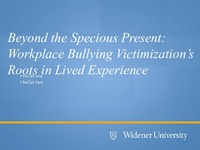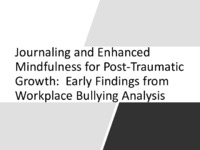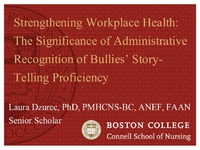| dc.contributor.author | Dzurec, Laura Cox | en |
| dc.date.accessioned | 2016-07-13T11:14:55Z | |
| dc.date.available | 2016-07-13T11:14:55Z | |
| dc.date.issued | 2016-07-13 | |
| dc.date.issued | 2016-07-13 | |
| dc.identifier | INRC16D02 | |
| dc.identifier.uri | http://hdl.handle.net/10755/616537 | |
| dc.description | <p>Theme: Leading Global Research: Advancing Practice, Advocacy, and Policy</p> | en |
| dc.description.abstract | <p>Session presented on Friday, July 22, 2016:</p>
<p><strong>Purpose:</strong> The purpose of this presentation is to begin to unravel features inherent in workplace bullying victimization so that targets--the intended objects of workplace bullies' assaults--can be differentiated from victims--those parties actually injured by workplace bullies' assaults. The face-to-face encounters that overtly characterize workplace bullying often are brief in duration and puerile (Dzurec, Kennison, & Albataineh, 2014). Some who are targeted by workplace bullies are able to walk away, literally or figuratively, from bullying encounters. For others, the influence of the typically childish and immature content of bullying assaults is devastating, resulting, paradoxically, in ongoing and paradoxical engagement in relationship with their bully counterparts. The self-same bullying communications dismissed by some represent vicious assaults to others, those who are somehow vulnerable to bullying affronts. Workplace bullying acts typically do not involve physical action. Instead, they involve taunts, misrepresentations, and nonverbal expressions such as eye rolling and sighing. While appearing inane and trivial, the acts that constitute workplace bullying raise questions about what the perpetrator is REALLY trying to say. Workplace bullying is, after all, essentially a 'communication phenomenon' (Cowan, 2012, p. 1). Its language reflects a convoluted process, potentially intended to shame (Dzurec, Kennison, & Albataineh, 2014) without ever a hint of physical force.</p>
<p><strong>Methods:</strong> Using pragmatic utility, the investigators analyzed a broad, published literature regarding workplace bullying, integrating knowledge from their previous research and practice experiences to differentiate the experiences of targets and victims.</p>
<p><strong>Results:</strong> Study findings suggest that bullying victimization is established not in the immediate, specious present but, rather, through redolence, as the brain acts to interpret the present in terms of a personal, lived past. For those targets ultimately victimized, redolent tacit and explicit knowledge emerging from lived experience revives bygone vulnerabilities, naive communication and relationship expectations, and suspicious perceptions about the strength and authenticity of organizational supports.</p>
<p><strong>Conclusion:</strong> Individual workplace bullying events serve as triggers that activate already-established assumptions regarding sense of self. In light of this finding, future research might address questions of what constitutes 'optimal' interventions in workplace bullying.</p> | en |
| dc.format | Text-based Document | en |
| dc.language.iso | en | en |
| dc.subject | Workplace Bullying | en |
| dc.subject | Victimization | en |
| dc.subject | Unhealthy Relationships | en |
| dc.title | Beyond the specious present: Workplace bullying victimization's roots in lived experience | en |
| dc.title.alternative | Symposium: Killing me softly: Anonymous abuse, victimization, and family-like dynamics in workplace bullying occurrences | en |
| dc.type | Presentation | en |
| dc.rights.holder | <p>
All rights reserved by the author(s) and/or publisher(s) listed in this item record unless relinquished in whole or part by a rights notation or a Creative Commons License present in this item record.
</p><p>
All permission requests should be directed accordingly and not to the Sigma Repository.
</p><p>
All submitting authors or publishers have affirmed that when using material in their work where they do not own copyright, they have obtained permission of the copyright holder prior to submission and the rights holder has been acknowledged as necessary.
</p> | en |
| dc.description.note | <p>Items submitted to a conference/event were evaluated/peer-reviewed at the time of abstract submission to the event. No other peer-review was provided prior to submission to the Henderson Repository.</p> | |
| dc.type.category | Full-text | en |
| dc.evidence.level | N/A | en |
| dc.research.approach | N/A | en |
| dc.contributor.department | Eta Beta | en |
| dc.author.details | Laura C. Dzurec, RN, PMHCNS-BC, ANEF | en |
| dc.conference.name | 27th international Nursing Research Congress | en |
| dc.conference.host | Sigma Theta Tau International | en |
| dc.conference.location | Cape Town, South Africa | en |
| dc.date.conferenceyear | 2016 | |
| dc.description.reviewtype | Abstract Review Only: Reviewed by Event Host | en |
| dc.description.acquisition | Proxy-submission | en |





